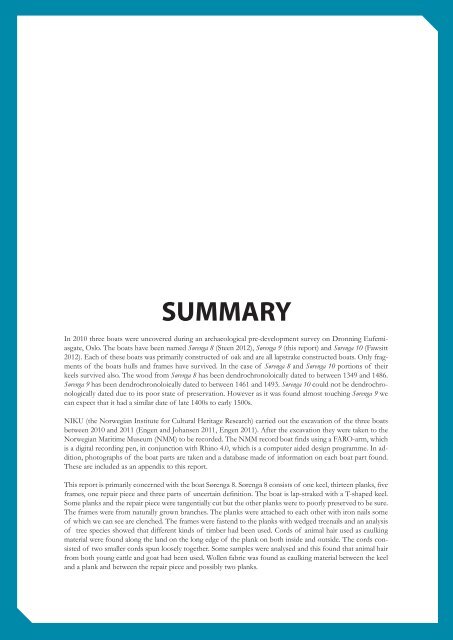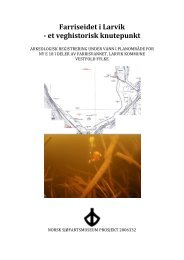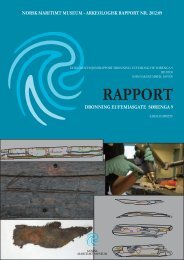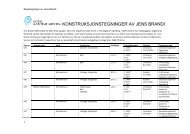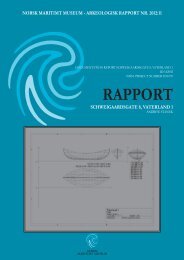Last ned 2009230_Sørenga8_rapport - Norsk Maritimt Museum
Last ned 2009230_Sørenga8_rapport - Norsk Maritimt Museum
Last ned 2009230_Sørenga8_rapport - Norsk Maritimt Museum
Create successful ePaper yourself
Turn your PDF publications into a flip-book with our unique Google optimized e-Paper software.
SUMMARY<br />
In 2010 three boats were uncovered during an archaeological pre-development survey on Dronning Eufemiasgate,<br />
Oslo. The boats have been named Sørenga 8 (Steen 2012), Sørenga 9 (this report) and Sørenga 10 (Fawsitt<br />
2012). Each of these boats was primarily constructed of oak and are all lapstrake constructed boats. Only fragments<br />
of the boats hulls and frames have survived. In the case of Sørenga 8 and Sørenga 10 portions of their<br />
keels survived also. The wood from Sørenga 8 has been dendrochronoloically dated to between 1349 and 1486.<br />
Sørenga 9 has been dendrochronoloically dated to between 1461 and 1493. Sørenga 10 could not be dendrochronologically<br />
dated due to its poor state of preservation. However as it was found almost touching Sørenga 9 we<br />
can expect that it had a similar date of late 1400s to early 1500s.<br />
NIKU (the Norwegian Institute for Cultural Heritage Research) carried out the excavation of the three boats<br />
between 2010 and 2011 (Engen and Johansen 2011, Engen 2011). After the excavation they were taken to the<br />
Norwegian Maritime <strong>Museum</strong> (NMM) to be recorded. The NMM record boat fi nds using a FARO-arm, which<br />
is a digital recording pen, in conjunction with Rhino 4.0, which is a computer aided design programme. In addition,<br />
photographs of the boat parts are taken and a database made of information on each boat part found.<br />
These are included as an appendix to this report.<br />
This report is primarily concer<strong>ned</strong> with the boat Sørenga 8. Sørenga 8 consists of one keel, thirteen planks, fi ve<br />
frames, one repair piece and three parts of uncertain defi nition. The boat is lap-straked with a T-shaped keel.<br />
Some planks and the repair piece were tangentially cut but the other planks were to poorly preserved to be sure.<br />
The frames were from naturally grown branches. The planks were attached to each other with iron nails some<br />
of which we can see are clenched. The frames were fastend to the planks with wedged treenails and an analysis<br />
of tree species showed that different kinds of timber had been used. Cords of animal hair used as caulking<br />
material were found along the land on the long edge of the plank on both inside and outside. The cords consisted<br />
of two smaller cords spun loosely together. Some samples were analysed and this found that animal hair<br />
from both young cattle and goat had been used. Wollen fabric was found as caulking material between the keel<br />
and a plank and between the repair piece and possibly two planks.


